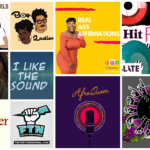Hit Parade: Being Smart about the Charts


Who has the most number one songs of all time on the Billboard 100 chart? The Beatles, of course, with 20. What is the best performing song of all time on the charts? The Twist by Chubby Checker in 1961. And the song that spent the most weeks at number one on the Billboard chart? Well, it’s tie – Luis Fonsi and Daddy Yankee with Justin Bieber on Depacito in 2017 and Mariah Carey and Boys II Men on One Sweet Day in 1995 into 1996. Both songs spent an amazing 16 weeks at number one.
Now, if any of this knowledge of popular songs and artists holds any interest for you then Slate’s Hit Parade podcast should be number one on your playlist. The podcast is hosted by Chris Molanphy, a chart analyst and pop critic, who writes about the intersection of culture and commerce in popular music.
Besides hosting the podcast for Slate, Molanphy writes its “Why Is This Song No. 1?” series. His writing has also appeared in Rolling Stone, Pitchfork, Vulture, NPR Music’s The Record, and Billboard. Molanphy is also a frequent guest on National Public Radio (Soundcheck, All Things Considered, Planet Money, On the Media) and on Slate’s podcasts The Gist and the Culture Gabfest.
Molanphy is the perfect deejay – if you will – for the podcast. His “made for audio” voice is crisp, authoritative, passionate and brewing with the aural magic of a master storyteller. And he can weave some stories. For example, in episode 21, Molanphy explains how Creedence Clearwater Revival (CCR) were a group of California boys who ironically found success with a Louisiana bayou sound. During the late 60s and early 70s, CCR compiled a record of both considerable and dubious achievement – the artist with the most number two hits without a number one single.
Hit Parade isn’t just a musical walk down memory lane for baby boomers who are still convinced that Paul McCartney is indeed dead. Molanphy’s deep dive into the song charts includes an episode on the growth of hip-hop and rap music and how it has morphed over the years. A recent episode even delved into R. Kelly and sexual harassment claims against him.
In a January 2018 Live episode at the Bell House in Brooklyn, NY Molanphy truly hit his stride. Using an audience trivia contest as his entertainment vehicle, Molanphy takes the listener into the deep recesses of B Side singles that became hits. B sides were the “throwaway” songs on the other side of a 45 record with the A side being the song designated as the hit. Beginning his story in 1956, Molanphy uses a trivia question for an audience member to immerse us into Elvis Presley’s “B” side monster hit “Hound Dog.”
Presley’s camp has recorded “Don’t Be Cruel,” a new song written for him and then included “Hound Dog” as the B side. Unbeknownst to most of us musical amateurs, Hound Dog had been a huge hit for Big Mama Thornton in 1953 and then a novelty hit for Freddie Bell and the Bellboys in 1955.
After the Don’t Be Cruel / Hound Dog single was released, Hound Dog eclipsed its A side with many TV music show hosts asking that Elvis perform that song instead of Don’t Be Cruel.
Finance exec John Kowalczuk, who works in Manhattan, attended the Brooklyn live show and described it like this. “Hit Parade Live was like a carnival atmosphere with trivia questions, so many ‘I didn’t know that’ moments and Molanphy walking you through life via popular music.”
Kowalczuk, an enthusiastic regular listener to Hit Parade, continues, “Molanphy also does these shorter episodes once a month called The Bridge usually with a guest like Mike Pesca from Slate’s The Gist podcast. A listener gets to answer a music trivia question on a specific topic – like the one on MTV – and the listener can then try to stump the host.”
To encourage paid Slate Plus membership, listeners who answer the trivia questions are Slate Plus members. To his credit, Molanphy doesn’t put the hard sell on paid membership but extols its virtues to his listeners.
In April of this year, Molanphy held another live show – this time in Seattle – and focused on posthumous hits by musical legends. For example, Otis Redding recorded his biggest chart hit – (Sittin” On) The Dock of the Bay in several sessions from August to November 1967. In early December, Redding was killed in a plane crash and by early 1968 Dock of The Bay was number one on the Pop and R&B charts.
But Molanphy and Hit Parade don’t just spit out pearls of music trivia. The show covers trends, directional switchbacks, and the shifting tides of the audience, who truly determine the direction of popular music.
For example, in episode 11, Molanphy discusses the rise of Brittany Spears and the powerhouse Swedish song factory represented by Max Martin. Instead of just focusing on Spears’ rise to celebrity via Star Search and the Mickey Mouse Club, Molanphy takes the listener back to ABBA in the 70s, the Swedish supergroup whose complex melodies were the genesis of U.S. teen pop at the turn of the century.
In fascinating detail, Molanphy explains the connective tissue between ABBA successors, Roxette (Frida from ABBA) and Ace of Base who worked with Swedish songwriter and uber-producer Denniz Pop, who spawned Max Martin (AKA Martin Sandberg). Martin wrote massive hits for Spears (Baby, One More Time) The Backstreet Boys (I want it that way) and NSYNC (It’s gonna be me).
Finally, in episode 27, Molanphy discusses hip-hop as the dominant music today and then uses his Hot Tub Time Machine to return us to 1986 when rappers
Run-D.M.C. covered Walk This Way with Aerosmith’s Steven Tyler and guitarist Joe Perry freestyling on the record. The song was a massive hit and opened doors for rap rock and solidified hip-hop as a bona fide genre on popular music charts.
Hit Parade, which only began in the Spring of 2017, is a podcast cleverly built for several audiences. For pop music nerds who can tell you that Shania Twain’s 1997 album Come On Over is the fourth highest selling album of all time, it’s geeking out on music’s most popular songs.
For people who attend trivia nights for more than the $2 beers, it’s the challenge of answering music trivia questions.
For casual music listeners, it’s the storytelling prowess of Chris Molanphy, the host. And for popular culture observers, it’s the linkage between politics, economics, race and popular music preferences that makes the podcast a terrific listen.













Comments
Comments are closed.